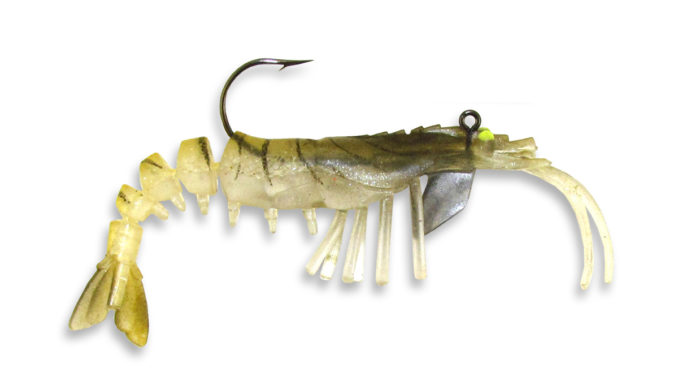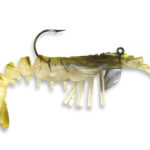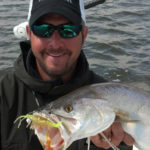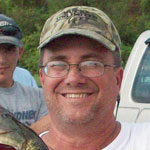
Better than the real thing?
Can an artificial lure — a soft plastic — outfish a natural creature? That day has arrived and it’s like magic, hence lure’s name, thanks to Ken Chaumont of Lacassine.
Several marinas along Louisiana’s coast are aware of that bona fide threat to the saltwater gamefish population any day or night of the week and acted accordingly by ordering ample supplies of arguably the hottest-selling saltwater artificial lures in the country, the Vudu Shrimp introduced to anglers by Chaumont and his Egret Baits.
Those callers told the man behind those Vudus that they believe the soft plastics will outsell live shrimp.
Chaumont, who has been in the artificial lure manufacturing business 34 years, isn’t surprised by the way Vudu Shrimp are catching speckled trout and redfish from Texas to Louisiana to Florida, Georgia and North Carolina, just to name a few of the coastal states being swept by Vudu Shrimp fever since they went on the market in January.
“I’ve been busy,” Chaumont said the last week of April, two months after Vudu Shrimp sales mushroomed.
Keeping up with demand from an overseas manufacturing operation has been his top priority.
“Every once in a while you hit a single and a double, and then the bases get loaded in the bottom of the ninth inning and you hit a grand slam,” said Chaumont. “That’s what happened. VuDu’s got legs of its own. Every now and then, one comes along where it catches so many fish it’s stupid. For the most part, word of mouth is rippling across the coast.”
Chaumont has hit homers before with baits like Rat-L-Trap’s Mini-Trap, which created a sensation on the bass-fishing scene.
Egret Baits’ Vudu Shrimp is 3 ¼ inches long, tough and armed with a light but strong, sharp hook on a special leadhead, a tail that moves seductively and eyes on the soft plastic that glow.
The 3/16-ounce lure started taking shape last October when Chaumont met his trusted engineer from China in Houston and they started on the project for Egret Baits, a company name chosen because the “best fishing machine in the world is the egret. I love the bird.”
“We wanted to build a look-alike shrimp,” Chaumont said. “We didn’t invent the shrimp. We took a shrimp and tried to make it look like a bait shrimp. People in Louisiana just love to fish with shrimp.”
Then came several months of intensive field testing with the prototypes, with which hundreds of speckled trout were fooled into biting in Calcasieu Lake. Many of those fish were in the 14- to 17-inch range over the main reef in Turner’s Bay.
Then the soft plastic went live, as they say, and the early reception was overwhelmingly positive in Texas and Louisiana. After that, Vudu Shrimp, each one painted individually in some of those most-realistic and appealing colors (Vudu Natural-04 and Vudu Gold-08 have been the go-to colors), spread like wildfire.
One of Louisiana’s veteran charter boat captains admitted recently he was skeptical when it first came out. After all, Bill Lake of Houma said, he hasn’t been a “real big fan of fishing” shrimp imitations in his 21 years owning Bayou Guide Service, which operates out of the speckled trout-fishing mecca that is the Dularge area.
His opinion changed quickly when he tied on a Vudu Shrimp, which he fished about 16 inches under a popping cork and then quite successfully tandem-rigged.
“Hell, yeah, it works,” Lake said. “I have used it quite extensively. In my opinion, it’s the best artificial shrimp on the market. There’s nothing more lifelike than the Vudu Shrimp.
“I guess the lifelikeness is the best thing about it. The resemblance is uncanny. It’s wonderful, man. Dude, it’s the real deal. They can’t keep it on the shelves down here. They love that sonuvagun.”
The Vudu Shrimp comes two to a package with a suggested retail price of $6.99.
Anglers and fishing guides say it is worth every penny because of the number of speckled trout that can be caught on just one of the soft plastics, with some estimates of up to 100 fish.
That’s because there is a nylon fabric netting (not Kevlar strands, as has been reported) woven into the tail section like a mesh that gives it increased durability, Chaumont said, adding through his personal experience “60 trout couldn’t break it.”
“I don’t know how many you can catch on them,” Lake said. “That mesh it’s got in the tail, they just can’t break it.”
He does know that, while filming a television fishing show for Casting Cajun, 100 speckled trout were caught and 60 of them came on one Vudu Shrimp fished under a popping cork. The sky’s the limit, in his opinion.
“You can catch 50 to 75 (trout) on one bait,” he said, noting he regularly catches doubles when he rigs them tandem. Lake said he couldn’t wait to fish with them at the barrier islands and near-offshore oil-field structures this year.
Youngsters and inexperienced anglers benefit the most whenever they tie on a Vudu Shrimp, he said.
Chaumont said he believed one of its most-alluring features is the pair of glowing eyes.
“Those eyes glow,” he said. “There’s only one thing (of a shrimp) that glows in the water — the eyes. We use a little dab of glow paint on the eyes.”
The colors are unreal, many have said.
“I especially love that gold color,” said Lake. “It’s the most lifelike I’ve ever seen. And natural’s a good one, too. Those are my favorites. I haven’t had a chance to try the others yet. I can’t wait.”
“Of course, we’re going to continue to grow the colors,” Chaumont said, adding one of the first new color combinations coming out will be the purple/gold hue that is so popular in LSU country and beyond because it c-a-t-c-h-e-s fish.
Egret Baits also plans to introduce a 4-inch model soon, he said. That means a larger hook that should make a difference when bull reds chomp down on the new Vudu Shrimp.
For more information on the Vudu Shrimp and other Egret Baits products, go to www.egretbaits.com or call 337-540-8234.






Be the first to comment